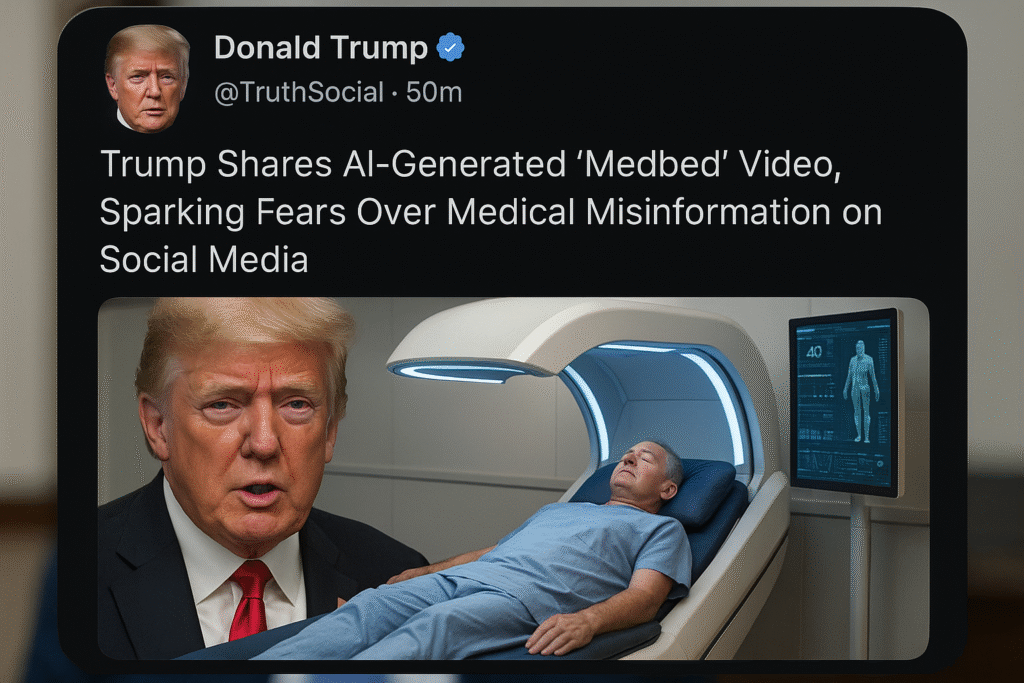By Harshit | September 30, 2025 | Washington, D.C. | 3:30 AM EDT
AI-Generated Trump Video Fuels Conspiracy Theories
Former President Donald Trump briefly shared an AI-generated video on his Truth Social account that promoted a so-called medical cure-all known as a “medbed.” The video, which has since been deleted, appeared to mimic the style of a Fox News broadcast hosted by Trump’s daughter-in-law, Lara Trump, though it never aired on the network.
The synthetic video featured an AI version of Trump claiming: “Every American will soon receive their own medbed card.” However, experts stress that “medbeds” are pure fiction — a conspiracy theory with roots in the QAnon movement that falsely promises advanced medical beds capable of curing all diseases.
While the video has been taken down, its circulation highlights a growing issue: the rapid spread of medical misinformation on social media, often amplified by AI-generated content that blurs the line between fact and fiction.
The Rise of the “Medbed” Conspiracy
The “medbed” narrative is not new. It has circulated in QAnon circles for years, claiming that powerful institutions are hiding futuristic healing technology from the public. Despite no evidence, the theory has resurfaced repeatedly on platforms like TikTok, Telegram, and fringe forums, often tied to broader claims of government cover-ups.
Experts warn that the latest Trump-linked AI clip shows how conspiracy theories can gain new traction when combined with realistic-looking deepfake content.
Misinformation’s Real-World Impact
The problem extends beyond fringe movements. According to a 2024 poll by the Kaiser Family Foundation, most Americans encounter false health claims online, and many remain uncertain about their accuracy.
“Misinformation isn’t a point of view, it does actual harm,” explained Brian Castrucci, president of the de Beaumont Foundation, which has studied the public health impacts of false medical claims. “It’s hurting physicians. It’s hurting medical practice. And it’s hurting the American public.”
Castrucci pointed to the COVID-19 pandemic as a stark example. During its peak, misinformation about hydroxychloroquine as a supposed cure led to shortages, leaving patients with autoimmune diseases struggling to access their prescribed medications.
Even outside of COVID-19, the damage continues. Castrucci, who has type 2 diabetes, noted that he constantly sees misleading online ads for so-called “diabetes cures,” despite the fact that no such remedies exist.
Declining Trust Between Doctors and Patients
The spread of medical misinformation also erodes trust. A 2023 poll found that nearly 70% of doctors believe patient trust declined between 2020 and 2022. While only 21% of the general public reported the same, experts say this gap underscores the strain misinformation places on the doctor–patient relationship.
Many Americans rely heavily on general internet searches for health guidance. Unlike doctors, who tend to consult scientific journals and medical colleagues, ordinary users are more likely to encounter unverified content in search results or on social media feeds — where misleading claims often spread faster than corrections.
How to Spot False Health Information
Public health experts emphasize that combating medical misinformation on social media requires vigilance from both professionals and everyday users.
Philosopher and author Lee McIntyre advises people to ask key questions: Where is this information coming from? Who benefits from spreading it? What do multiple reliable sources say?
Dr. Richard Baron, president and CEO of the American Board of Internal Medicine, added: “When you start to see information converging from reliable sources — like the CDC, well-known hospitals, and peer-reviewed journals — that is trustworthy information.”
Dr. Franziska Haydanek, an OBGYN and online health educator, stresses that individuals should use online health insights as conversation starters with their doctors, not as replacements for professional care. “If you come across something online, bring it to your physician. Say: ‘I read about this condition, could it apply to me?’ That’s how misinformation can be safely managed.”
Why This Matters Now
The Trump “medbed” video is more than an isolated incident. It represents a convergence of two major challenges: the rise of AI-generated deepfakes and the persistent spread of conspiracy-driven medical misinformation.
Health organizations, including the World Health Organization (WHO), warn that disinformation undermines trust in government, weakens public health messaging, and ultimately puts lives at risk.
As Castrucci put it: “Social media has made it easier to spread medical misinformation — not from town to town, but to millions with one click.”







